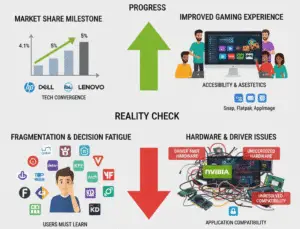
Supply Chain Attacks in 2025: The Invisible Threat That Could Cripple Your Business
Introduction: Why You Should Care About Supply Chain Attacks
Imagine this: Your company installs what appears to be a routine software update. Suddenly, your entire network is locked down by ransomware. Hackers didn’t attack you directly—they infiltrated through one of your trusted vendors. This is a supply chain attack, and in 2025, they’re becoming more sophisticated, more damaging, and scarier than ever.
In this guide, we’ll explain:
-
What supply chain attacks are (with real 2024-2025 examples)
-
How they work (step-by-step breakdown)
-
Which industries are most at risk
-
How to protect your business (actionable security measures)
What Are Supply Chain Attacks?
A supply chain attack occurs when hackers compromise a company by targeting its weaker vendors, suppliers, or service providers instead of attacking it directly.
Why They’re So Dangerous in 2025
-
They bypass traditional defenses (you trust your vendors, so their access isn’t heavily monitored)
-
One breach can infect thousands (as seen in the SolarWinds and MOVEit attacks)
-
They’re getting harder to detect (AI-powered attacks leave fewer traces)
How Do Supply Chain Attacks Work? (Step-by-Step)
Step 1: Hackers Identify a Weak Link
Attackers look for:
-
Small IT vendors with poor security
-
Open-source software libraries
-
Third-party cloud services
Example: In 2024, hackers breached a payroll software company, gaining access to 300+ corporate clients.
Step 2: They Inject Malicious Code
Common methods:
-
Poisoned software updates (malware hidden in “legitimate” patches)
-
Compromised hardware (infected USB drives, servers, IoT devices)
-
Hijacked login credentials (stolen vendor passwords)
Example: A 2025 attack on a tax software provider inserted ransomware into tax filing updates.
Step 3: The Attack Spreads Automatically
Once inside, the malware:
-
Moves laterally across networks
-
Steals data or deploys ransomware
-
Waits silently before striking (sometimes for months)
Example: The 2023 MOVEit breach affected over 2,000 organizations globally.
Real-World Supply Chain Attacks (2024-2025)
| Attack | What Happened | Impact |
|---|---|---|
| The “ShadowPay” Hack (2024) | Hackers compromised a payroll provider, altering bank details for thousands of employees. | $45M stolen before detection. |
| The “UpdateGate” Breach (2025) | A fake “critical security update” for accounting software installed spyware. | 500+ companies infected. |
| The “Chipocalypse” Incident (2024) |
Counterfeit network chips with backdoors were shipped to tech firms. | Corporate espionage at scale. |
Who’s Most at Risk?
1. Small & Medium Businesses (SMBs): The Weakest Link in
Supply Chains
Why They’re Vulnerable
-
Limited IT Security Budgets: Can’t afford advanced threat detection systems
-
Over-Reliance on Cheap Vendors: Often prioritize cost over security when selecting suppliers
-
No Dedicated Cybersecurity Team: May lack staff to properly vet third parties
Major Weak Points
-
Accounting/HR Software Providers
-
Many use low-cost cloud payroll services (like compromised in 2024’s “ShadowPay” attack)
-
Often grant excessive access permissions
-
-
Web Development Agencies
-
Freelancers/offshore teams frequently get hacked
-
Can inject malicious code into company websites
-
-
Office Equipment Suppliers
-
Infected USB drives or routers have caused multiple breaches
-
Protection Strategies



Real Example: A 2024 attack on a marketing SaaS provider led to 800 SMBs being infected with ransomware through compromised email templates.
2. Healthcare Organizations: Life-or-Death Vulnerabilities
Why They’re Vulnerable
-
Legacy Medical Devices: MRI machines/IV pumps often run Windows XP (!) with no updates
-
Emergency Mindset: “Patient care first” leads to security shortcuts
-
Complex Vendor Ecosystems: A single hospital uses 50+ software vendors
Major Weak Points
-
Medical Device Manufacturers
-
FDA-approved devices can’t be easily patched
-
Default passwords like “admin123” still common
-
-
Health Record Platforms
-
Cloud EHR providers targeted for mass data theft
-
Shared login portals are prime targets
-
-
Pharmacy/Supply Vendors
-
Hackers altered drug orders in 2023’s “MediPharm” breach
-
Protection Strategies



Real Example: A 2025 attack on a ventilator software update forced 3 hospitals to pay $5M in ransom to avoid patient harm.
3. Government Agencies: Bureaucracy Breeds Risk
Why They’re Vulnerable
-
Outdated Procurement Rules: Lowest-bidder contracts go to insecure vendors
-
Fragmented Systems: 50 different departments = 50 attack surfaces
-
Nation-State Targeting: China/Russia actively infiltrate defense contractors
Major Weak Points
-
Defense Contractors
-
Small parts suppliers often lack basic encryption
-
Blueprints for jets/tanks stolen via sub-vendors
-
-
Cloud Service Providers
-
Shared platforms used by multiple agencies
-
2024’s “GovCloud” breach exposed 11M records
-
-
Maintenance Contractors
-
Janitorial staff with building access planted USB malware
-
Protection Strategies



Real Example: A state DMV’s license plate vendor was hacked in 2024, enabling fake ID creation for 240,000 vehicles.
4. Financial Institutions: Where the Money Flows
Why They’re Vulnerable
-
Fintech Dependencies: Many banks rely on small startups with weak security
-
Regulatory Complexity: GDPR/SOX/PCI DSS create security blind spots
-
Insider Threat Potential: Vendor employees often abuse access
Major Weak Points
-
Payment Processors
-
Compromised in 70% of banking breaches
-
Often use shared API keys instead of proper authentication
-
-
ATM Service Companies
-
Remote maintenance access exploited to drain cash
-
Physical tampering at vendor warehouses
-
-
Credit Scoring Agencies
-
Provide data to thousands of lenders
-
2025’s “ScoreGate” leak exposed 160M credit reports
-
Protection Strategies



Real Example: A bank lost $28M in 2024 when hackers compromised their SWIFT transfer vendor’s test environment.
Universal Protection Framework for All Industries
Technical Controls
-
Software Bill of Materials (SBOM): Know every component in vendor software
-
Hardware Security Modules (HSM): Protect cryptographic keys from vendors
-
Deception Technology: Fake vendor portals to trap attackers
Human Controls
-
Vendor Security Scorecards: Grade each supplier quarterly
-
Breach Simulation Drills: Practice responding to vendor compromises
-
Whistleblower Programs: Reward for reporting vendor risks
Insurance/Legal
-
Cyber Insurance Requirements: Minimum $5M coverage for critical vendors
-
Liquidated Damages Clauses: Financial penalties for vendor security failures
-
Right-to-Audit Contracts: Must allow unannounced security inspections
Remember: In 2025, you’re not just buying a product/service—you’re buying that vendor’s security posture too. Treat vendor selection like hiring a security guard for your vault.
The Future of Supply Chain Attacks (2025+)
-
AI-Powered Attacks: Malware that adapts to bypass detection
-
Quantum Risks: Future quantum computers may break current encryption used in supply chains
-
Tighter Regulations: New laws will force companies to vet vendors more strictly
The bottom line? Supply chain attacks won’t disappear—they’ll evolve. Companies that prepare now will survive.
Conclusion: Don’t Be the Next Victim
Supply chain attacks are like poison in your coffee—you won’t see it coming until it’s too late. In 2025, every business is at risk, but you can fight back by:
-
Vetting vendors aggressively
-
Controlling update processes
-
Preparing for breaches before they happen
Remember: Your security is only as strong as your weakest vendor. Act now before hackers do.




